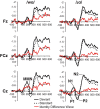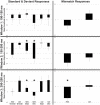Phonological Underspecification: An Explanation for How a Rake Can Become Awake
- PMID: 33679342
- PMCID: PMC7925882
- DOI: 10.3389/fnhum.2021.585817
Phonological Underspecification: An Explanation for How a Rake Can Become Awake
Abstract
Neural markers, such as the mismatch negativity (MMN), have been used to examine the phonological underspecification of English feature contrasts using the Featurally Underspecified Lexicon (FUL) model. However, neural indices have not been examined within the approximant phoneme class, even though there is evidence suggesting processing asymmetries between liquid (e.g., /ɹ/) and glide (e.g., /w/) phonemes. The goal of this study was to determine whether glide phonemes elicit electrophysiological asymmetries related to [consonantal] underspecification when contrasted with liquid phonemes in adult English speakers. Specifically, /ɹɑ/ is categorized as [+consonantal] while /wɑ/ is not specified [i.e., (-consonantal)]. Following the FUL framework, if /w/ is less specified than /ɹ/, the former phoneme should elicit a larger MMN response than the latter phoneme. Fifteen English-speaking adults were presented with two syllables, /ɹɑ/ and /wɑ/, in an event-related potential (ERP) oddball paradigm in which both syllables served as the standard and deviant stimulus in opposite stimulus sets. Three types of analyses were used: (1) traditional mean amplitude measurements; (2) cluster-based permutation analyses; and (3) event-related spectral perturbation (ERSP) analyses. The less specified /wɑ/ elicited a large MMN, while a much smaller MMN was elicited by the more specified /ɹɑ/. In the standard and deviant ERP waveforms, /wɑ/ elicited a significantly larger negative response than did /ɹɑ/. Theta activity elicited by /ɹɑ/ was significantly greater than that elicited by /wɑ/ in the 100-300 ms time window. Also, low gamma activation was significantly lower for /ɹɑ/ vs. /wɑ/ deviants over the left hemisphere, as compared to the right, in the 100-150 ms window. These outcomes suggest that the [consonantal] feature follows the underspecification predictions of FUL previously tested with the place of articulation and voicing features. Thus, this study provides new evidence for phonological underspecification. Moreover, as neural oscillation patterns have not previously been discussed in the underspecification literature, the ERSP analyses identified potential new indices of phonological underspecification.
Keywords: EEG; ERP; ERSP; MMN; gamma; phonology; theta; underspecification.
Copyright © 2021 Cummings, Wu and Ogiela.
Conflict of interest statement
The authors declare that the research was conducted in the absence of any commercial or financial relationships that could be construed as a potential conflict of interest.
Figures







Similar articles
-
Converging evidence for [coronal] underspecification in English-speaking adults.J Neurolinguistics. 2017 Nov;44:147-162. doi: 10.1016/j.jneuroling.2017.05.003. Epub 2017 May 29. J Neurolinguistics. 2017. PMID: 29085183 Free PMC article.
-
Evidence for [Coronal] Underspecification in Typical and Atypical Phonological Development.Front Hum Neurosci. 2020 Dec 22;14:580697. doi: 10.3389/fnhum.2020.580697. eCollection 2020. Front Hum Neurosci. 2020. PMID: 33414710 Free PMC article.
-
No place for /h/: an ERP investigation of English fricative place features.Lang Cogn Neurosci. 2016 Jul 2;31(6):728-740. doi: 10.1080/23273798.2016.1151058. Epub 2016 Mar 31. Lang Cogn Neurosci. 2016. PMID: 27366758 Free PMC article.
-
Maturation of mismatch negativity in typically developing infants and preschool children.Ear Hear. 2002 Apr;23(2):118-36. doi: 10.1097/00003446-200204000-00005. Ear Hear. 2002. PMID: 11951848 Review.
-
Good enough processing: what have we learned in the 20 years since Ferreira et al. (2002)?Front Psychol. 2024 Jan 24;15:1323700. doi: 10.3389/fpsyg.2024.1323700. eCollection 2024. Front Psychol. 2024. PMID: 38328385 Free PMC article. Review.
References
-
- Archangeli D. (1988). Aspects of underspecification theory. Phonology 5, 183–207.
-
- Bernhardt B., Stoel-Gammon C. (1994). Nonlinear phonology: introduction and clinical application. J. Speech Hear. Res. 37, 123–143. - PubMed
Grants and funding
LinkOut - more resources
Full Text Sources
Other Literature Sources

